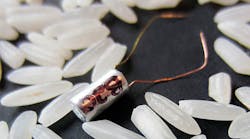Researchers use tiny transmitters to track the migration of salmon and other fish. These transmitters must be powered by batteries, though, affecting the age and range of the fish that can be monitored and limiting the scope of their studies. The Pacific Northwest National Laboratory has developed a smaller and more powerful battery that should improve this tracking.
Related Articles
- Micro-windmills Power Portable Devices
- How To Build A Better Battery
- Understanding Lithium Batteries In Portable Electronics
At 6 mm long and 3 m wide, the micro-battery is a little larger than a long grain of rice (see the figure). Smaller batteries mean smaller transmitters, which then can be implanted in younger fish to give scientists a better view of their life cycle. With more power, these transmitters can broadcast signals over longer distances so researchers can track fish further from shore or from dams, or deeper in the water.
“There’s nothing like this available commercially that can be injected,” said Daniel Deng, a PNNL engineer who was part of the battery’s development team. “Either the batteries are too big or they don’t last long enough to be useful. That’s why we had to design our own.”
The battery uses the “jellyroll” technique commonly used in household cylindrical batteries. Battery materials are placed on top of each other in a process known as lamination and then rolled up together. The layers include a separating material sandwiched by a cathode made of carbon fluoride and an anode made of lithium.
This technique increases the area of the electrodes without increasing their thickness or the battery’s overall size. It also keeps the impedance from getting too high, which can be a problem in small batteries as electrons don’t have the space to flow easily or quickly along their required routes. The jellyrolling creates a larger space for the electrons to interact.
The battery weighs 70 mg and boasts 240 watt hours per kilogram, compared to the 135 mg 100 watt hours per kilogram of commercially available silver-oxide button micro-batteries. It can power a 744-µs signal sent every three seconds for about three weeks, or five seconds for a month. Also, it works better in the cold waters where salmon often live, thanks to its lithium and carbon-fluoride chemistry.
The scientists cut and formed tiny snippets of battery materials and put them through a flattening device like a pasta maker, binding them together and rolling them by hand into tiny capsules. Last summer, a PNNL team implanted battery-powered tags into salmon in the Snake River with extremely good preliminary results reported. Battelle, which operates PNNL, has applied for a patent on the technology.
